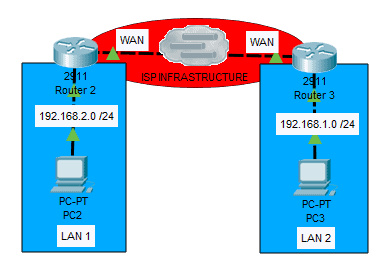Organizations are constantly expanding into different branches with different locations. To connect the two branches, we are leveraging the infrastructure of Internet Service Provider to provide connectivity between the branches. The network connection outside of the organization’s network is called Wide Area Network (WAN).
The ISP is providing us with a subscription-based WAN connection type for us to have access to our resources remotely. Another notable application of WAN is the internet. We can connect to the internet because of the WAN provided by our local Internet Service Providers. We’ll discuss each WAN connection type below.
Wide Area Network Connectivity
Wide Area Network (WAN) is a telecommunication network that is used to simply extend a LAN over a large geographical distance. Technically, two or more local area networks can be connected via WAN with different layer 3 devices like routers or firewalls.
Most WAN IP address uses the static public IP address, dynamic public IP address, and PPPoE (Point-to-Point Protocol) as the connection to the ISP depending on the subscription. Static public IP addresses are much expensive as compare to dynamic and PPPoE because we only have limited unique public IP address that cannot be reused by other customers. Private IP addresses are only routable on the local network and not routable over WAN or the internet. The below diagram shows the LAN and WAN infrastructure.
WAN Connection Types
There are many WAN connections that we use to provide our connectivity to the internet. Below are the common options for WAN connectivity from the internet provider.
- Leased Line
This WAN connection type is a dedicated point-to-point link and fixed-bandwidth data connection. By using leased lined, your network will have a completely secured and reliable connection, high bandwidth, and superior quality of service. On the other side, leased lines can be expensive and not scalable as it is a permanent physical connection.
- Digital Subscriber Line
DSL is a medium used to transfer digital signals over the standard telephone lines. It uses a different frequency than the telephone is using so that you can use the internet while making a call. DSL is an older concept that provides a typical speed of around 6mbps. The good thing in DSL is the bandwidth is not shared and provides a constant speed.
- Cable Internet
One way to provide broadband internet connection is by using cable internet from a local cable TV provider. It has quite a similarity with DSL as it also uses an existing cable modem from cable TV to send data. On this connection, the speed varies with the number of users on the service at a specific time.
- Fiber Internet Access
It is the newest broadband connection that provides the highest internet speed service to the customers. It is also commonly used in telecommunication backhaul connections because of the higher speed it can handle as compared to other cables. DWDM, SONET, and SDH are the ISP backhaul transport equipment that uses fiber optic cable. Fiber optic is also used in telecom packet switching networks or circuit switching networks.
- Multi-Protocol Label Switching (MPLS)
MPLS is a type of VPN that uses labels on forwarding packets instead of IP addresses or layer 3 headers. It offers optimum security and routing for customer’s sites. On MPLS, the service provider is participating in the customer’s routing.
- Wireless WAN
Most of us are using mobile phones that use mobile data to connect to the internet. The commonly known connection types for wireless WAN are 3G, 4G, LTE, and 5G. It is the services offered by local ISP to provide wireless internet access to mobile devices via cellular sites. It uses specific frequencies to provide wider coverage and stronger signal to customers.
Download our Free CCNA Study Guide PDF for complete notes on all the CCNA 200-301 exam topics in one book.
We recommend the Cisco CCNA Gold Bootcamp as your main CCNA training course. It’s the highest rated Cisco course online with an average rating of 4.8 from over 30,000 public reviews and is the gold standard in CCNA training:

